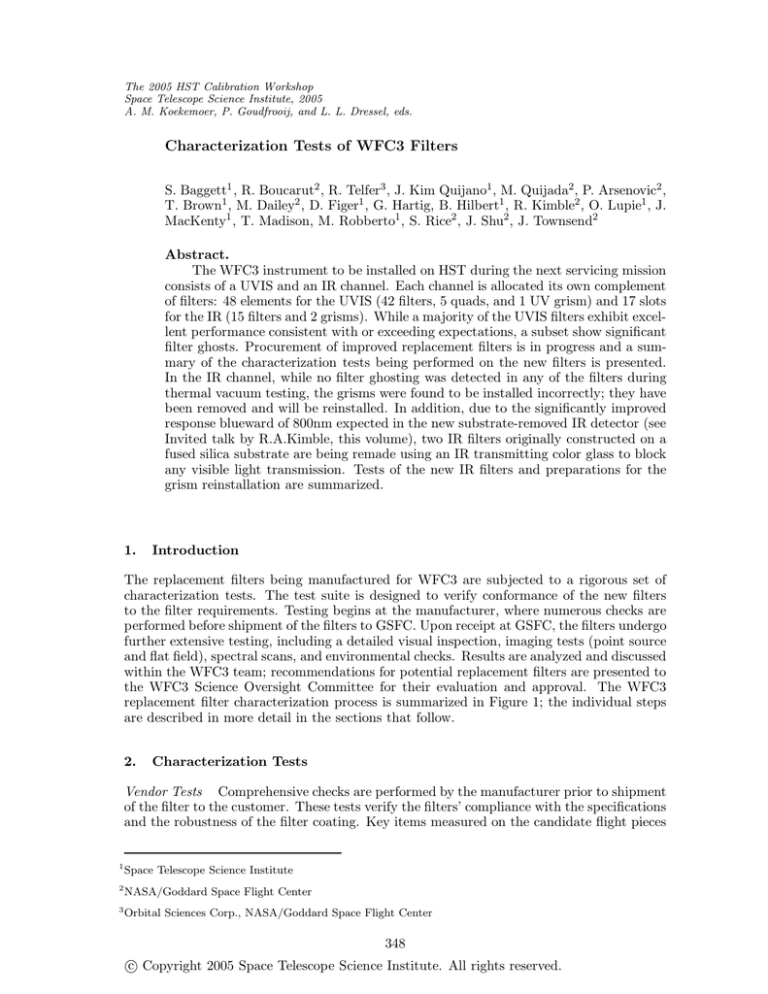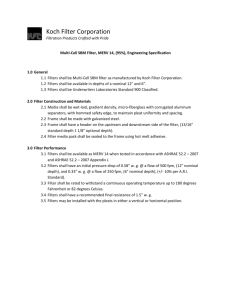
The 2005 HST Calibration Workshop
Space Telescope Science Institute, 2005
A. M. Koekemoer, P. Goudfrooij, and L. L. Dressel, eds.
Characterization Tests of WFC3 Filters
S. Baggett1 , R. Boucarut2 , R. Telfer3 , J. Kim Quijano1 , M. Quijada2 , P. Arsenovic2 ,
T. Brown1 , M. Dailey2 , D. Figer1 , G. Hartig, B. Hilbert1 , R. Kimble2 , O. Lupie1 , J.
MacKenty1 , T. Madison, M. Robberto1 , S. Rice2 , J. Shu2 , J. Townsend2
Abstract.
The WFC3 instrument to be installed on HST during the next servicing mission
consists of a UVIS and an IR channel. Each channel is allocated its own complement
of filters: 48 elements for the UVIS (42 filters, 5 quads, and 1 UV grism) and 17 slots
for the IR (15 filters and 2 grisms). While a majority of the UVIS filters exhibit excellent performance consistent with or exceeding expectations, a subset show significant
filter ghosts. Procurement of improved replacement filters is in progress and a summary of the characterization tests being performed on the new filters is presented.
In the IR channel, while no filter ghosting was detected in any of the filters during
thermal vacuum testing, the grisms were found to be installed incorrectly; they have
been removed and will be reinstalled. In addition, due to the significantly improved
response blueward of 800nm expected in the new substrate-removed IR detector (see
Invited talk by R.A.Kimble, this volume), two IR filters originally constructed on a
fused silica substrate are being remade using an IR transmitting color glass to block
any visible light transmission. Tests of the new IR filters and preparations for the
grism reinstallation are summarized.
1.
Introduction
The replacement filters being manufactured for WFC3 are subjected to a rigorous set of
characterization tests. The test suite is designed to verify conformance of the new filters
to the filter requirements. Testing begins at the manufacturer, where numerous checks are
performed before shipment of the filters to GSFC. Upon receipt at GSFC, the filters undergo
further extensive testing, including a detailed visual inspection, imaging tests (point source
and flat field), spectral scans, and environmental checks. Results are analyzed and discussed
within the WFC3 team; recommendations for potential replacement filters are presented to
the WFC3 Science Oversight Committee for their evaluation and approval. The WFC3
replacement filter characterization process is summarized in Figure 1; the individual steps
are described in more detail in the sections that follow.
2.
Characterization Tests
Vendor Tests Comprehensive checks are performed by the manufacturer prior to shipment
of the filter to the customer. These tests verify the filters’ compliance with the specifications
and the robustness of the filter coating. Key items measured on the candidate flight pieces
1
Space Telescope Science Institute
2
NASA/Goddard Space Flight Center
3
Orbital Sciences Corp., NASA/Goddard Space Flight Center
348
c Copyright 2005 Space Telescope Science Institute. All rights reserved.
Characterization Tests of WFC3 Filters
349
Figure 1: The characterization test process.
include the spectral throughput (primary bandpass as well as out of band blocking), transmissive wavefront (on uncoated substrate as well as the coated filter), and quality control
(check of length, width, thickness, inspection for scratches and cosmetic defects, painting of
any pinholes, and cleaning). Characteristics such as the coating integrity (adhesion quality, resistance to abrasions, temperature and humidity cycling) and radiation hardness are
performed on witness or flight-like pieces.
Inspection Upon receipt of the filter from the vendor, a detailed inspection is performed.
The dimensions of the filter are confirmed and the item is inspected for any blemishes or
coating defects. Photographs, both front and backlit, are taken to document the condition
of the filter and map any pinholes which may be present (see Figure 2a).
Imaging Extensive point source imaging is done with each filter; tests are performed using
white (either xenon or deuterium lamp) as well as monochromatic (200-1000nm) light.
These data allow for measurement of filter ghosts (strength, appearance, and behavior),
as well as wavefront, wedge, and focus shift. Figure 2b shows a whitelight image of a
candidate F689M filter. The image was taken at a relatively high filter tilt angle; this moves
the ghost away from the PSF and facilitates measurement of the ghost level. The setup
ghost is an artifact of the lab setup and appears even without a filter in the beam. Images
are taken at a variety of tilt angles and translation positions as well as in configurations
simulating seventeen points distributed across the WFC3 field of view. Figure 3a presents
a monochromatic scan of the ghosts measured in a candidate filter. The monochromatic
results are used to constrain the model, which in turn is used to predict ghost behavior
as a function of target spectral type. Figure 3b shows a small subset of images from a
phase retrieval dataset. Focus sweeps are obtained through a 9x9 array of 10mm apertures
covering the filter, separated by steps of 5mm. Wavefront data taken without a filter are
subtracted, including focus and tilt, yielding wavefront error, focus shift, and wedge.
350
Baggett et al.
Figure 2: (a) At left is a pinhole image of F280N. (b) At right is an image of the ghost
in F689M; filter ghost is at upper left; the feature to the left of the PSF is due to the lab
setup.)
Figure 3: (a) The plot at left shows the excellent agreement between the monochromatic
data and model for an F218W filter. Note: the fairly high ghost intensities shown occur
out of band, where the filter blocking is significant; integrated over a continuum source, the
relative ghost strengths are much lower. (b) The image at right shows a mosaic of a small
subset of PSFs taken during a typical phase retrieval test.
Characterization Tests of WFC3 Filters
351
Figure 4: The FilterGEISt lab setup is used for obtaining imaging data of candidate filters.
Imaging tests are performed using FilterGEISt (filter ghost evaluation imaging station,
see photo in Figure 4), a dedicated lab setup which reproduces the WFC3 UVIS + HST optical parameters. A 4-axis stage assembly provides repeatable translation/rotation motions
as well as simulations of sources within the WFC3 FOV.
Spectral Scans The spectral throughput of the filter is measured both in and out of band
using a PerkinElmer 950. Scans are taken at multiple points to allow an assessment of
uniformity. In-band UVIS scans are performed in a 5x5 grid across the filter while out of
band UVIS scans are executed in the center of the filter and at the four corners. Figures 5a
and 5b illustrate typical in and out of band scans which are evaluated in light of the input
specifications.
Flat field images The fine scale transmission properties of the filter are verified via flat
fielding. The imaging setup is designed to simulate that of the WFC3 internal calibration system (divergent beam). The entire filter is covered, to check for blemishes, coating
degradation, or any other anomalies that may be present.
Environmental Tests Filter witnesses and non-flight pieces are subjected to temperature
cycling under thermal vacuum (TV) conditions in order to verify the robustness of the
coatings. Baseline inspections, spectral scans, and flat fields are taken prior to the test.
The cycles are designed to mimic the TV conditions the filters are expected to experience
during ground testing and on-orbit. After the cycles, another round of inspections, spectral
scans, and flatfields are taken to check for any evidence of coating degradation.
Filter Selection The final choice of which, if any, replacement filters to fly resides with the
WFC3 Science Oversight Committee, with analysis inputs from the STScI and GSFC WFC3
teams. The decision is based upon a careful balance of the characterization test results for
352
Baggett et al.
Figure 5: (a) The plot at left presents a representative inband transmission scan, in this
case, for an F410M candidate. (b) The image at right shows the blocking scan for an F467M
candidate.
Figure 6: (a) The plot at left summarizes the new UV replacement filter bandpasses. (b)
At right are spectral scans for the old and new visible filters.
the new filters versus the characteristics of the current flight filters as determined from
previous filter tests as well as instrument-level ambient and thermal vacuum tests.
3.
Replacement Filters
The UV is a critical part of the WFC3 bandpass coverage; Figure 6a summarizes the new
UV replacement filter bandpasses. In most cases, the filter development technology now
available has provided increased throughput in addition to reducing the ghost levels. For
example, in F225W (which showed the most improvement) the ghost levels are reduced from
about 15 percent to less than 0.3 percent and the new filter grasp (integral of the filter and
WFC3 transmission over wavelength in the primary bandpass) is about 30 percent more
than the original flight filter. Ghost levels in the visible filters have been reduced as well
(some even eliminated) and again, in most cases the grasp of the new filter is higher than
in the old filter. Figure 6b provides a comparison of the bandpasses of the original and new
visible filters.
Characterization Tests of WFC3 Filters
353
Figure 7: Plots showing typical inband (a) and out of band (b) transmission curves for a
candidate F125W filter.
4.
IR filter testing
No filter ghosts were found in the IR filters during instrument-level testing but two filters
originally constructed on fused silica (because the QE of the original IR detector was low in
the blue) must be remade on an IR-transmitting color glass (IR80). The change is driven
by the new IR detectors under development, which are being thinned to reduce particleinduced luminescence in the CdZnTe substrate; the new detectors will have significant QE
well blueward of 800nm. As with the UVIS filters, the IR replacement filters undergo a full
set of characterization tests, including spectral scans at a variety of locations on the filter
as well as at two temperatures (room temperature and nominal operating temperature of
-30C). Given the relatively small filter size (25.4mm in diameter for IR, 53.2mm square
for UVIS), the in-band IR scans are performed at 5 points and the out of band scans
at filter center, as illustrated in Figure 7a and 7b. An IR InGaAS IR array camera will
be incorporated into the FilterGEISt lab setup, in order to measure wavefront, wedge, and
perform a ghost check. Finally, the two IR grisms which were installed incorrectly have been
removed and will be reinstalled in the upcoming year. One of the grisms is being remade
with an improved red edge in order to reduce the transmission of thermal background
radiation, which led to an undesirably high background on the detector in thermal vacuum
testing.
5.
For more information about WFC3
http://www.stsci.edu/hst/wfc3/ and http://wfc3.gsfc.nasa.gov






